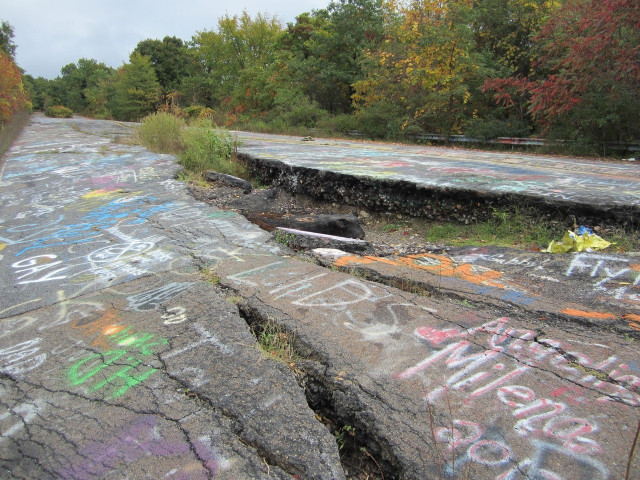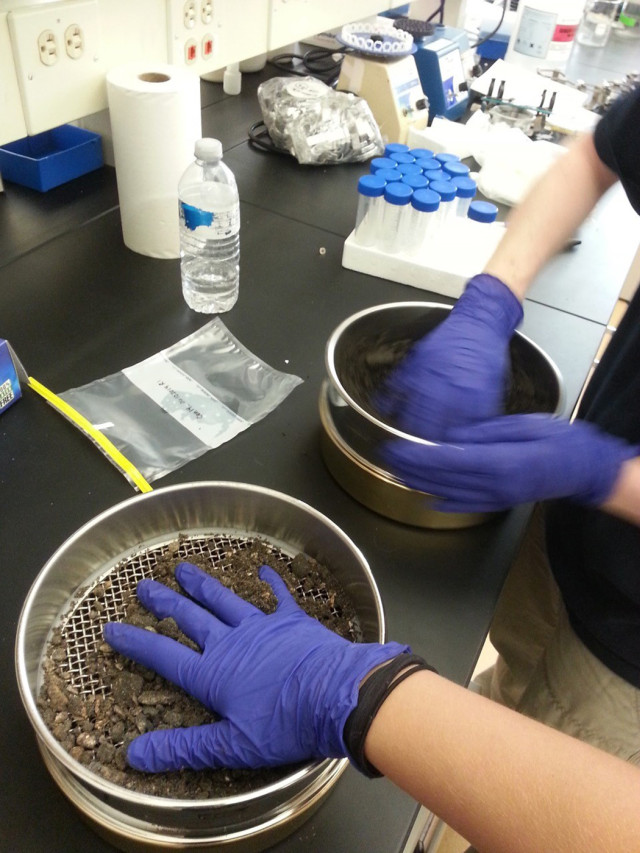
by Hannah Gavin Thursday, February 7, 2019

A stretch of abandoned road in Centralia, Pa., where a subterranean coal seam fire has been burning for decades, altering conditions in overlying soils. Credit: courtesy of MSU
Centralia, Pa., sits above rich subterranean coal seams, which made the town a mining center for about a century. In 1962, the seams were accidentally ignited by burning garbage, turning the coal from a commodity into a liability. Nearly 57 years later, the ground beneath Centralia is still smoldering.
Driven away by fire-associated hazards and particulate air pollution, all but a few human residents have long since abandoned the town. However, a new study reveals that the same isn’t true for all forms of life: A diverse population of microbial life resides in Centralia’s hot soils. These heat-tolerant microbes are offering scientists novel insights into the composition and character of soil microbial communities and resilience in response to dramatic ecosystem change.
The “bizarre alien ecosystem” that has resulted from the Centralia fires presents a unique research opportunity, says Ashley Shade, a microbiologist at Michigan State University and a co-author of the new study in Nature Microbiology. Shade and her colleagues investigate microbial community dynamics, particularly how bacteria and archaea contend with environmental perturbations.
Soil inhabitants inherently experience a wide range of conditions. But the sustained high heat and release of coal-combustion products from the Centralia fire have pushed the overlying soils there to further extremes that have affected multiple generations of resident organisms, Shade says.

Researchers studied the microbes present in soils sampled from directly above, and adjacent to, the Centralia coal seam fire. Credit: courtesy of MSU
In the new study, Shade and her colleagues collected soils from the top 20 centimeters below the ground surface, including soils directly above, and adjacent to, the coal seam fire. The coolest soils were just above 10 degrees Celsius and the hottest exceeded 55 degrees Celsius. Then they used DNA sequencing to identify and analyze the genomes of the microbes present in the different soils to examine the relationship between temperature and microbial genome size in a single, natural setting, testing “the capacity of [microbial] communities to contend with disturbance,” Shade says. The team found a strong inverse relationship between soil temperature and microbe genome size: Microbes living in the hottest soils contained much less genetic material on average than those in the cooler neighboring soils that are more representative of undisturbed conditions in the area.
Previous studies had hinted at similar results, including an analysis based on data from microbes found in disparate locations and another, lab-based study that demonstrated that marine bacteria in warmer water usually have smaller genomes compared to bacteria in cooler water.
Together, these results indicate that in the case of bacteria and archaea surviving extreme heat, a minimalist genome approach seems to be the way to go, but why small genomes are favored under hot circumstances isn’t yet clear. A 2013 study in Genome Biology and Evolution suggested that bacteria and archaea with smaller genomes tend to have smaller cell sizes as well, so perhaps the small genomes in warm settings are a byproduct of selection for small cell size.
Microbial evolution to a more streamlined state is often suggested as a route to small genomes, says Jo Handelsman, a soil microbiologist at the University of Wisconsin-Madison who was not involved in the new study. Shade’s team found that some of the abundant microbes living in the warmer soils they studied were also present, in small numbers, in neighboring ambient soils. Such a result suggests that in this case, “thermo-tolerant cells are not the outcome of active genome reduction,” Handelsman notes. Rather, the small genomes observed in the new study are “characteristic of thermophiles in the soil that were previously dormant and [then] reproduce in response to fire exposure.”
It has been estimated that up to 80 percent of bacteria are dormant in the environment. Plant biologists have long appreciated that soils contain dormant plant seeds, making up plant “seed banks.” But when it comes to analogous populations of inactive microbes, “I don’t think anyone knows how deep or how ancient a [microbial] ‘soil seed bank’ is,” Shade says, nor do we know what other extreme conditions dormant microbes might be capable of tolerating.
Studies like this one help researchers understand microbial community stability — the ability to resist and recover from environmental disturbances, Shade says.
Predicting how an ecosystem will change requires an understanding of its smallest members, Handelsman notes. After all, she adds, microbial communities “are at the heart of all ecosystems on Earth.”
© 2008-2021. All rights reserved. Any copying, redistribution or retransmission of any of the contents of this service without the expressed written permission of the American Geosciences Institute is expressly prohibited. Click here for all copyright requests.